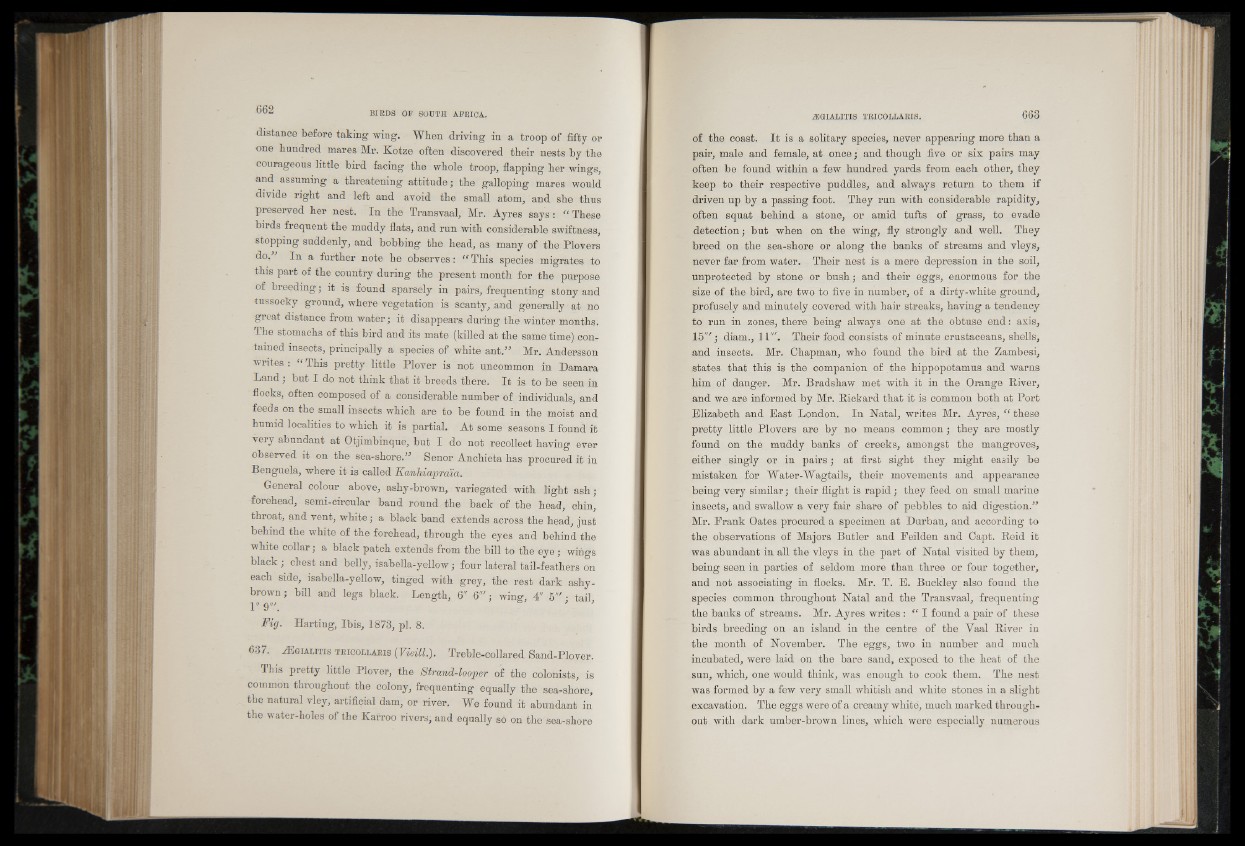
distance before taking wing. When driving in a troop of fifty or
one hundred mares Mr. Kotze often discovered their nests by the
courageous little bird facing the whole troop, flapping her wings,
and assuming a threatening attitude; the galloping mares would
divide right and left and avoid the small atom, and she thus
preserved her nest. In the Transvaal, Mr. Ayres says : “ These
birds frequent the muddy flats, and run with considerable swiftness,
stopping suddenly, and bobbing the head, as many of the Plovers
do. In a further note he observes: “ This species migrates to
this part of the country during the present month for the purpose
of breeding; it is found sparsely in pairs, frequenting stony and
tussocky ground, where vegetation is scanty, and generally at no
great distance from water; it disappears during the winter months.
The stomachs of this bird and its mate (killed at the same time) contained
insects, principally a species of white ant.” Mr. Andersson
writes : “ This pretty little Plover is not uncommon in Damara
Land; but I do not think that it breeds there. It is to be seen in
flocks, often composed of a considerable number of individuals, and
feeds on the small insects which are to be found in the moist and
humid localities to which it is partial. At some seasons I found it
very abundant at Otjimbinque, but I do not recollect having ever
observed it on the sea-shore.” Senor Anchieta has procured it in
Benguela, where it is called Kanhiopraia.
General colour above, ashy-brown, variegated with light ash;
forehead, semi-circular band round the back of the head, chin,
throat, and vent, white; a black band extends across the head, just
behind the white of the forehead, through the eyes and behind the
white collar; a black patch extends from the bill to the eye; wings
black ; chest and belly, isabella-yellow; four lateral tail-feathers on
each side, isabella-yellow, tinged with grey, the rest dark ashy-
brown; bill and legs black. Length, 6" 6'"; wing, 4" 5"' • tail
2 '/ g /// 9 9
Fig. Harting, Ibis, 1873, pi. 8.
637. Z E g i a l i t i s t b i c o l l a b i s {Vieill.). Treble-collared Sand-Plover.
This pretty little Plover, the Strand-looper of the colonists, is
common throughout the colony, frequenting equally the sea-shore,
the natural vley, artificial dam, or river. We found it abundant in
the water-holes of the Karroo rivers, and equally so on the sea-shore
of the coast. It is a solitary species, never appearing more than a
pair, male and female, at once; and though five or six pairs may
often be found within a few hundred yards from each other, they
keep to their respective puddles, and always return to them if
driven up by a passing foot. They run with considerable rapidity,
often squat behind a stone, or amid tufts of grass, to evade
detection; but when on the wing, fly strongly and well. They
breed on the sea-shore or along the banks of streams and vleys,
never far from water. Their nest is a mere depression in the soil,
unprotected by stone or bush; and their eggs, enormous for the
size of the bird, are two to five in number, of a dirty-white ground,
profusely and minutely covered with hair streaks, having a tendency
to run in zones, there being always one at the obtuse end: axis,
15'"; diam., 11'". Their food consists of minute crustaceans, shells,
and insects. Mr. Chapman, who found the bird at the Zambesi,
states that this is the companion of the hippopotamus and warns
him of danger. Mr. Bradshaw met with it in the Orange River,
and we are informed by Mr. Rickard that it is common both at Port
Elizabeth and East London. In Natal, writes Mr. Ayres, “ these
pretty little Plovers are by no means common; they are mostly
found on the muddy banks of creeks, amongst the mangroves,
either singly or in pairs; at first sight they might easily be
mistaken for Water-Wagtails, their movements and appearance
being very similar; their flight is rapid ; they feed on small marine
insects, and swallow a very fair share of pebbles to aid digestion.”
Mr. Frank Oates procured a specimen at Durban, and according to
the observations of Majors Butler and Peilden and Capt. Reid it
was abundant in all the vleys in the part of Natal visited by them,
being seen in parties of seldom more than three or four together,
and not associating in flocks. Mr. T. E. Buckley also found the
species common throughout Natal and the Transvaal, frequenting
the banks of streams. Mr. Ayres writes : I found a pair of these
birds breeding on an island in the centre of the Vaal River in
the month of November. The eggs, two in number and much
incubated, were laid on the bare sand, exposed to the heat of the
sun, which, one would think, was enough to cook them. The nest
was formed by a few very small whitish and white stones in a slight
excavation. The eggs were of a creamy white, much marked throughout
with dark umber-brown lines, which were especially numerous